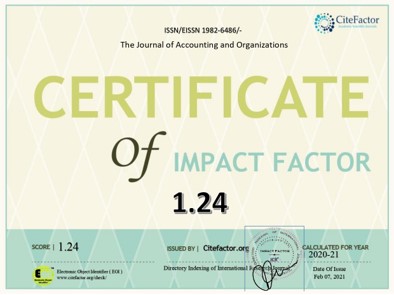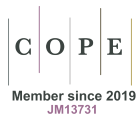Understanding corruption-fighting factors: proposing a corruption deterrence construct
DOI:
https://doi.org/10.11606/issn.1982-6486.rco.2019.158516Keywords:
Corruption, Causes of corruption, Protection against corruption, Public organizations, GovernanceAbstract
The purpose of the article is to create a corruption protection construct that can explain the variation of corruption in different countries. This construct, called DECIDE, was based on four indicators related to administrative burden reduction, democracy, institutional quality and open government data, represented respectively by Global Open Data Index, Democracy Index, Ease of doing Business Raking, and Institutional Quality Index. These four indicators were analysed with the Corruption Perception Index (CPI). A database was created that was analyzed following all the requirements of the technique Partial Least Squares (PLS). The main result was the creation of DECIDE, which explains 50% of the CPI's perception of corruption during these years. The DECIDE, in turn, is explained by the four indicators. This construct provides a foundation for the context to be less conducive to corruption while broadening protection mechanisms. In practical terms, the study identifies that a less bureaucratic, more democratic, more transparent country where institutions work best is more protected from corruption, whereas these four variables act as a deterrent to corruption.
Downloads
References
DOI:10.1046/j.0013-0133.2003.00171.x.
Aladwani, A. M. (2016). Corruption as a source of e-Government projects failure in developing countries: A
theoretical exposition. International Journal of Information Management, 36(1), 105-112. DOI: http://dx.doi.
org/10.1016/j.ijinfomgt.2015.10.005.
Andvig, J. C., Fjeldstad, O. H., Amundsen, I., & Søreide, T. (2000). Research on Corruption A policy oriented
survey. Commissioned by Norad, 158p.
Brei, Z. A. (1996). Corruption, ethics and administration, corruption and morality in administration public, political
corruption, administrative corruption. Revista de Administração Pública, 30(1), 64.
Brol, M. (2016). Institutional determinants of corruption. Ekonomia i Prawo. Economics and Law, 15(1), 21-32.
DOI: http://dx.doi.org/10.12775/eip.2016.002.
Burrell, G. (8). Morgan, G.(1979). Sociological Paradigms and Organizational Analysis. Elements of the Sociology
of Corporate Life. Ashgale Publishing Company: Burlington, USA.
Cohen, J. Statistical Power Analysis for the Behavioral Sciences. 2nd ed. New York: Psychology Press, 1988.
Del Monte, A., & Papagni, E. (2001). Public expenditure, corruption, and economic growth: the case of Italy.
European Journal of Political Economy, 17(1), 1-16. DOI: http://dx.doi.org/10.1016/s0176-2680(00)00025-
2.
Dias, J., & Bento, F. (2011). Corrupção e teoria econômica. Economia & Tecnologia, 7(26), 1-8. DOI: http://
dx.doi.org/10.5380/ret.v7i3.26615.
Ferraz, C., & Finan, F. (2008). Exposing corrupt politicians: the effects of Brazil's publicly released audits on
electoral outcomes. The Quarterly journal of economics, 123(2), 703-745. DOI: http://dx.doi.org/10.1162/
qjec.2008.123.2.703.
Fornell, C., & Larcker, D. F. (1981). Structural equation models with unobservable variables and measurement
error. Algebra and statistics. DOI: http://dx.doi.org/10.2307/3150980.
Gouvea, R., Montoya, M., & Walsh, S. (2013). How the corruption Quadruple Helix affects BRIC: A case study of
corruption in big emerging economies. J. Pol. & L., 6(1). DOI: http://dx.doi.org/10.5539/jpl.v6n2p1.
Habib, M., & Zurawicki, L. (2002). Corruption and foreign direct investment. Journal of International Business
Studies, 33(2), 291-307. DOI: http://dx.doi.org/0.1057/palgrave.jibs.8491017.
Hair Jr, J. F., Hult, G. T. M., Ringle, C., & Sarstedt, M. (2016). A primer on partial least squares structural equation
modeling (PLS-SEM). Sage publications. DOI: http://dx.doi.org/10.1080/1743727x.2015.1005806.
Hui, A. K., Armstrong, B. H., & Wray, A. A. (1978). Rapid computation of the Voigt and complex error
functions. Journal of Quantitative Spectroscopy and Radiative Transfer, 19(5), 509-516. DOI: http://dx.doi.
org/10.1016/0022-4073(78)90019-5.
Index, C. P. (2017). Transparency international. Disponível em: https://www.transparency.org/cpi2018.
Kaufmann, D., Kraay, A., & Mastruzzi, M. (2006). Measuring Corruption: Myths and Realities. The World Bank,
8(2), 37-41. Disponível em: http://documents.worldbank.org/curated/en/573111468314083144/pdf/436210N
EWS0BOX0327375B01PUBLIC1.pdf#page=39.
Klitgaard, R. (1988). Controlling corruption. University of California Press, 230p.
Knack, S. (2006). Measuring corruption in Eastern Europe and Central Asia: a critique of the cross-country
indicators. The World Bank. Disponível em: https://openknowledge.worldbank.org/handle/10986/8377.
Krishnan, S., Teo, T. S., & Lim, V. K. (2013). Examining the relationships among e-government maturity,
corruption, economic prosperity and environmental degradation: A cross-country analysis. Information &
Management, 50(8), 638-649. DOI: http://dx.doi.org/10.1016/j.im.2013.07.003.
Teles, V. K. (2007). Institutional quality and endogenous economic growth. Journal of Economic Studies, 34(1),
29-41. DOI: http://dx.doi.org/10.1108/01443580710717200.
Lui, F. T. (1986). A dynamic model of corruption deterrence. Journal of Public Economics, 31(2), 215–236. DOI:
http://dx.doi.org/10.1016/0047-2727(86)90019-8.
Miller, S. (1999). Noble cause corruption in policing. African Security Studies, 8(3), 12-22.
Melo, F. L. N. B. de, Sampaio, L. M. B., & de Oliveira, R. L. (2015). Corrupção burocrática e empreendedorismo:
Uma análise empírica dos estados brasileiros. Revista de Administração Contemporânea, 19(3), 374-397.
DOI: http://dx.doi.org/10.1590/1982-7849rac20151611.
Nascimento, J. C. H. B. do, & Silva-Macedo, M. A. da. (2016). Modelagem de equações estruturais com mínimos
quadrados parciais: um exemplo da aplicação do SmartPLS® em pesquisas em Contabilidade. Revista de
Educação e Pesquisa em Contabilidade, 10(3), 289-313.
Pascarelli Filho, M. (2013). A nova administração pública: profissionalização, eficiência e governança. DVS
Editora.
Power, T. J., & González, J. (2003). Cultura política, capital social e percepções sobre corrupção: uma investigação
quantitativa em nível mundial. Revista de Sociologia e Política, (21), 51-69.
Puron-Cid, G., Reddick, C. G., & Ganapati, S. (2019). Public value of online financial transparency: Financial
sustainability and corruption of public officials in the US state governments. International Journal of Public
Sector Management. DOI: https://doi.org/10.1108/IJPSM-03-2018-0073.
Ringle, C. M., Silva, D. da, & Bido, D. D. S. (2014). Modelagem de equações estruturais com utilização do
SmartPLS. Revista Brasileira de Marketing, 13(2), 56-73. DOI: https://doi.org/10.5585/remark.v13i2.2717.
Rotberg, R. I. (2019). Corruption in North America: Canada and the United States. In Canada–US Relations, 261-
282). Palgrave Macmillan, Cham.
SANTOS, R. A. D. (2013). Institutionalising anti-corruption in Brazil: the path of the Controladoria-Geral da
Uniao (CGU). 323f (Doctoral dissertation, Tese. Department of Politics, University of Sheffield, Sheffield,
Inglaterra).
Silva, L. A. S. D. (1999). Corrupção e promiscuidade entre os setores público e privado na gestão do sistema
financeiro nacional: a liberalização financeira e a abertura da conta de capital (as contas CC-5). Brasília,
DF: Confederação Nacional dos Bispos do Brasil (not published).
Speck, B. W. (2003). A compra de votos: uma aproximação empírica. Opinião Pública, 9(1), 148-169. DOI: http:
/dx.doi.org/10.1590/s0104-62762003000100006.
Srivastava, S. C., Teo, T. S., & Devaraj, S. (2016). You Can't Bribe a Computer: Dealing with the Societal Challenge
of Corruption Through ICT. Mis Quarterly, 40(2), 511-526.
Taylor, M. M., & Buranelli, V. C. (2007). Ending up in pizza: accountability as a problem of institutional arrangement in Brazil. Latin American Politics and Society, 49(1), 59-87. DOI: http://dx.doi.org/10.1111/j.1548-2456.2007.tb00374.x.
Timothy, J., & González, J. (2003). Cultura política, capital social e percepções sobre corrupção: uma investigação
quantitativa em nível mundial. Revista de Sociologia e Política, 21.
TOOLKIT, U. A. C. (2004). The Global Programme Against Corruption: UN Anti-Corruption Toolkit. UNODC.
Disponível em: https://www.un.org/ruleoflaw/blog/document/the-global-programme-against-corruption-unanti-corruption-toolkit/.
Downloads
Published
Issue
Section
License
The RCO adopts the Free Open Access policy, under the standard Creative Commons agreement (CC BY-NC-ND 4.0). The agreement provides that:
- Submission of text authorizes its publication and implies commitment that the same material is not being submitted to another journal. The original is considered definitive.
- Authors retain the copyright and grant the journal the right of first publication, with the work simultaneously licensed under the Creative Commons Attribution License which allows the sharing of the work with acknowledgment of authorship and initial publication in this journal.
- Authors are authorized to take additional contracts separately, for non-exclusive distribution of the version of the work published in this journal (e.g. publish in an institutional repository or as a book chapter), with necessary recognition of authorship and initial publication in this journal.
- Authors are allowed and encouraged to publish and distribute their work online (e.g. in institutional repositories or on their personal page) before or during the editorial process, as this can generate productive changes as well as increase the impact and citation of published work (See The Effect of Free Access).
- The journal does not pay copyright to the authors of the published texts.
- The journal's copyright holder, except those already agreed in the Free Open Access Agreement (CC BY-NC-ND 4.0), is the Accounting Department of the Faculty of Economics, Administration and Accounting of Ribeirão Preto of the University of São Paulo.
No submission or publication fees are charged.
Up to 4 authors per article are accepted. Exceptionally duly justified cases may be reviewed by the Executive Committee of the RCO. Exceptional cases are considered as: multi-institutional projects; manuscripts resulting from the collaboration of research groups; or involving large teams for evidence collection, construction of primary data, and comparative experiments.
It is recommended that the authorship be ordered by contribution of each of the individuals listed as authors, especially in the design and planning of the research project, in obtaining or analyzing and interpreting data, and writing. Authors must declare the actual contributions of each author, filling the letter to the editor, at the beginning of the submission, taking responsibility for the information given.
Authors are allowed to change throughout the evaluation process and prior to the publication of the manuscript. The Authors should indicate the composition and final order of authorship in the document signed by all those involved when accepted for publication. If the composition and authoring order is different than previously reported in the system, all previously listed authors should be in agreement.
In the case of identification of authorship without merit or contribution (ghost, guest or gift authorship), the RCO follows the procedure recommended by COPE.







